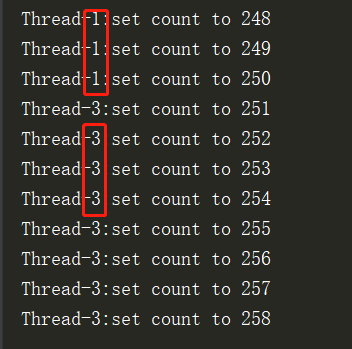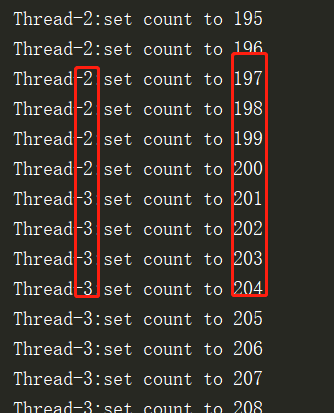import threading
count = 0
def print_time(threadName):
global count
c = 0
while(c<100):
c+=1
count +=1
print("{0}:set count to {1}".format(threadName,count))
try:
threading.Thread( target=print_time, args=("Thread-1", ) ).start()
threading.Thread( target=print_time, args=("Thread-2", ) ).start()
threading.Thread( target=print_time, args=("Thread-3", ) ).start()
except Exception as e:
print("Error: unable to start thread")
结果“ 每个thread对count进行改动期间while(c<100),有其它的thread插入进来改动count

通过threading.Lock() 实现,通过Lock的acquire()和release()函数来控制加锁和解锁,使用简单得方法 with实现
import threading
lock = threading.Lock()
count = 0
def print_time(threadName):
global count
c = 0
with lock:
while(c<100):
c+=1
count +=1
print("{0}:set count to {1}".format(threadName,count))
try:
threading.Thread( target=print_time, args=("Thread-1", ) ).start()
threading.Thread( target=print_time, args=("Thread-2", ) ).start()
threading.Thread( target=print_time, args=("Thread-3", ) ).start()
except Exception as e:
print("Error: unable to start thread")
结果

通过threading.Rlock() 实现
import threading
rlock = threading.RLock()
count = 0
def print_time(threadName):
global count
c = 0
with rlock:
while(c<100):
c+=1
count +=1
print("{0}:set count to {1}".format(threadName,count))
try:
threading.Thread( target=print_time, args=("Thread-1", ) ).start()
threading.Thread( target=print_time, args=("Thread-2", ) ).start()
threading.Thread( target=print_time, args=("Thread-3", ) ).start()
except Exception as e:
print("Error: unable to start thread")
j结果

Lock和Rlock的区别
import threading lock = threading.Lock() #Lock对象 lock.acquire() lock.acquire() #产生了死琐。 lock.release() lock.release()
import threading lock = threading.RLock() #Lock对象 lock.acquire() lock.acquire() 程序不会堵塞 lock.release() lock.release()
| Locks | RLocks |
|---|---|
|
A Lock object can not be acquired again by any thread unless it is released by the thread which which is accessing the shared resource. 一个lock被释放前不能被其他线程获得acquire |
An RLock object can be acquired numerous times by any thread. 一个Rlock可以被其他任意线程获得 |
|
A Lock object can be released by any thread. 一个lock可以被其他线程释放 |
An RLock object can only be released by the thread which acquired it. Rlock只能被获得他的线程释放 |
|
A Lock object can be owned by one lock被一个线程占有 |
An RLock object can be owned by many threads Rlock可以被其他线程获得 |
|
Execution of a Lock object is faster. lock的运行速度快 |
Execution of an RLock object is slower than a Lock object 运行速度比lock慢 |
这两种琐的主要区别是:RLock允许在同一线程中被多次acquire。而Lock却不允许这种情况。注意:如果使用RLock,那么acquire和release必须成对出现,即调用了n次acquire,必须调用n次的release才能真正释放所占用的琐